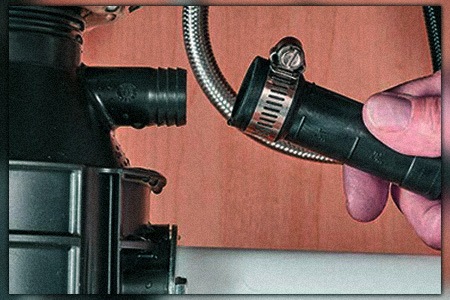Tested Solutions for Fixing a Dripping Garbage Disposal
Tested Solutions for Fixing a Dripping Garbage Disposal
Blog Article
Here in the next paragraph you'll find a bunch of excellent content regarding Why Is .

Garbage disposals are crucial kitchen appliances that help in dealing with food waste successfully. Nonetheless, a dripping waste disposal unit can be a discouraging and messy problem to handle. Fortunately, numerous leakages can be dealt with quickly with a few simple actions. In this write-up, we will certainly review just how to take care of a dripping waste disposal unit successfully.
Introduction
Waste disposal unit are set up under cooking area sinks and are created to shred food waste into smaller sized items, permitting it to travel through the pipes system conveniently. While these gadgets are generally reliable, leaks can happen gradually due to deterioration, loose connections, or damage to the unit.
Typical Sources Of Leakages in Garbage Disposals
Worn Seals and Gaskets
Seals and gaskets play a critical role in stopping water from dripping out of the waste disposal unit. Over time, these components can wear away, resulting in leakages around the disposal system.
Loose Links
The connections in between the garbage disposal and the pipes system can come to be loosened over time, causing water to leakage out throughout procedure.
Splits or Holes in the Disposal Unit
Physical damages to the waste disposal unit, such as cracks or openings in the housing, can also cause leakages.
Identifying the Source of the Leakage
Prior to trying to fix a leaking garbage disposal, it is vital to recognize the source of the leak. This can normally be done with visual examination or by conducting easy tests.
Visual Assessment
Evaluate the waste disposal unit unit carefully for any kind of indications of water leak. Pay close attention to areas around seals, gaskets, and connection points.
Testing for Leaks
One way to evaluate for leakages is by running water through the disposal device and looking for any kind of noticeable signs of leakage.
Devices and Products Needed for Repairing a Dripping Garbage Disposal
Prior to beginning the fixing procedure, gather the essential tools and materials, including a screwdriver, flexible wrench, plumber's putty, replacement seals or gaskets, and epoxy or patching material for repairing fractures or openings.
Step-by-Step Guide to Dealing With a Leaking Waste Disposal Unit
Turn Off the Power
Before trying any type of repairs, guarantee that the power to the garbage disposal unit is switched off to prevent the risk of electrical shock.
Find the Leak
Determine the exact area of the leakage and identify the cause.
Tighten Connections
Utilize a wrench to tighten any kind of loose links between the disposal system and the plumbing system.
Change Seals or Gaskets
If the leakage results from worn seals or gaskets, get rid of the old elements and replace them with brand-new ones.
Patching Splits or Holes
For fractures or holes in the disposal system, use epoxy or an ideal patching product to secure the damaged area.
Testing the Garbage Disposal After Repair Work
When the fixing is complete, test the garbage disposal by running water via it to make certain that the leakage has actually been dealt with.
Preventive Upkeep Tips to Prevent Future Leakages
To stop future leakages, it is vital to do regular maintenance on your waste disposal unit. This consists of keeping it clean, avoiding placing non-food items or difficult objects down the disposal, and regularly checking for leakages or other concerns.
Conclusion
Finally, repairing a dripping waste disposal unit is a reasonably straightforward process that can be finished with standard tools and materials. By following the steps detailed in this article and exercising preventative maintenance, you can keep your waste disposal unit in good working problem and prevent pricey repair work in the future.
What to Do About a Leaking Garbage Disposal
A leaking garbage disposal often goes unnoticed until you confront a sopping cabinet, a foul-smelling puddle, or an audible drip-drip-drip from the unit. The fix can be frustrating, too, because the leak can stem from a number of components in the system. Fortunately, with a little sleuthing, you can zero in on the leak and—depending on the exact location—stop the icky oozing and repair the component that caused it. Worst case scenario, if it turns out that the garbage disposal must be replaced, installing a new one is a reasonable do-it-yourself task for those with basic plumbing skills. Read on to keep the cash you’d otherwise hand over to a pro.
Prepare to find the leak
Prior to testing the garbage disposal for leaks, unplug it at the wall outlet and turn off the power from the breaker box to prevent electrical shock. Then insert a watertight sink stopper into your sink drain and wipe the unit dry with a clean cloth. In any handy container, mix a few drops of food coloring into a few cups of water, and pour the dyed water onto the sink stopper to help you locate the leak.
Investigate the source
the top, where the disposal meets the sink drain the side, where the dishwasher hose or main drain pipe connects to the disposal or the bottom of the unit Inspect each of these locations while gliding a light-colored rag over the unit; the dyed water will readily show on the rag and reveal the location of the leak. If a leak isn’t immediately apparent, remove the sink stopper and pour a few more cups of dyed water down the sink drain, then check for leaks again. Leaks near the top of the unit are more likely to show themselves while the sink is plugged, while side and bottom leaks are more noticeable while the sink is unplugged.
The metal sink flange that sits directly inside the sink drain is typically sealed around the top with plumber’s putty (a clay-like sealant) and then secured from under the sink with bolts. If the plumber’s putty deteriorates, or the bolts loosen, the flange can no longer form a watertight seal between the sink drain and the disposal—which could cause a leak at the top of the unit.
To reseal the leaky flange, you must first detach the garbage disposal. Start by loosening the screws securing the main drain pipe to the disposal, then loosen the screws in the metal clamp securing the dishwasher hose to the disposal and detach the drain pipe and dishwasher hose from the disposal. Loosen the screws in the mounting ring that connects the disposal to the metal mounting assembly beneath the sink, then pull down the disposal and carefully set it on a clean, dry surface. Loosen the bolts in the mounting assembly with a wrench, then pull down the mounting assembly and set it near the disposal.

I have been very occupied with Why Is and I really hope you liked the entire page. Those who liked our blog entry please don't forget to pass it around. Thanks a lot for your time invested reading it.
Estimate Free Report this page